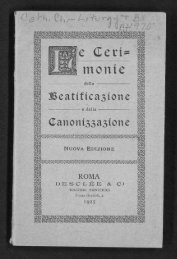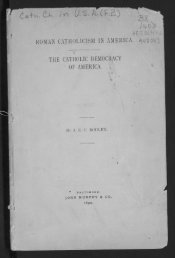Fabiola : or, The church of the catacombs - Digital Repository Services
Fabiola : or, The church of the catacombs - Digital Repository Services
Fabiola : or, The church of the catacombs - Digital Repository Services
You also want an ePaper? Increase the reach of your titles
YUMPU automatically turns print PDFs into web optimized ePapers that Google loves.
o<strong>the</strong>rwise, under <strong>the</strong> exciting f<strong>or</strong>ebodings <strong>of</strong> a coming perse-<br />
<strong>of</strong>ficer <strong>of</strong> n M have given<br />
Ilia <strong>or</strong>ders m<strong>or</strong>e briskly, <strong>or</strong> m<strong>or</strong>e decidedly, f<strong>or</strong> <strong>the</strong> dr.<br />
a f<strong>or</strong>tified city committed to his skill to guard, than ho issued<br />
Ids to <strong>the</strong> sub<strong>or</strong>dinate superintendents <strong>of</strong> <strong>the</strong> various cemeteries<br />
round B<strong>or</strong>ne, who met him by appointment at his own house,<br />
to learn <strong>the</strong> instructions <strong>of</strong> <strong>the</strong> superi<strong>or</strong> assembly. <strong>The</strong> shadow<br />
<strong>of</strong> <strong>the</strong> sun-dial at <strong>the</strong> P<strong>or</strong>ta Capeua was pointing to mid-day,<br />
as he issued from it with his sons, and found already waiting<br />
<strong>the</strong> three young men. <strong>The</strong>y walked in parties <strong>of</strong> two along<br />
<strong>the</strong> Appian road ; and at nearly two miles from <strong>the</strong> gate,* <strong>the</strong>y<br />
entered by various ways (slipping round different tombs that<br />
lined <strong>the</strong> road) into <strong>the</strong> same villa on <strong>the</strong> right hand. Here<br />
<strong>the</strong>y found all <strong>the</strong> requisites f<strong>or</strong> a descent into <strong>the</strong> subterranean<br />
cemeteries, such as candles, lanterns, and <strong>the</strong> instruments<br />
f<strong>or</strong> procuring light. Severus proposed that, as <strong>the</strong><br />
guides and <strong>the</strong> strangers were in equal number, <strong>the</strong>y should<br />
be divided into pairs ; and in <strong>the</strong> division he allotted T<strong>or</strong>-<br />
quatus to himself. What his reason was we may easily con-<br />
jecture.<br />
It would probably weary our readers to follow <strong>the</strong> whole con-<br />
versation <strong>of</strong> <strong>the</strong> party. Diogenes not only answered all ques-<br />
tions put to him, but, from time to time, gave intelligent little<br />
lectures, on such objects as he considered peculiarly attractive.<br />
But we believe we shall better interest and inf<strong>or</strong>m our friends,<br />
if we digest <strong>the</strong> whole matter <strong>of</strong> <strong>the</strong>se into a m<strong>or</strong>e connected<br />
narrative. And besides, <strong>the</strong>y will wish to know something <strong>of</strong><br />
<strong>the</strong> subsequent hist<strong>or</strong>y <strong>of</strong> those wonderful excavations, into<br />
which we have conducted our youthful pilgrims.<br />
<strong>The</strong> hist<strong>or</strong>y <strong>of</strong> <strong>the</strong> early Christian cemeteries, <strong>the</strong> Catacombs,<br />
as <strong>the</strong>y are commonly called, may be divided into three p<strong>or</strong>tions<br />
: from <strong>the</strong>ir beginning to <strong>the</strong> period <strong>of</strong> our narrative, <strong>or</strong> a<br />
few years later ; from this term to <strong>the</strong> eight century ; <strong>the</strong>*<br />
down to our own time, when we have reason to hope that a new<br />
epoch is being commenced.<br />
St. Agnes, <strong>of</strong> St. Pancratius, <strong>of</strong> Prsetextatus, Priseilla,<br />
Hermes, &c. Sometimes <strong>the</strong>se cemeteries were known by <strong>the</strong><br />
names <strong>of</strong> <strong>the</strong> places where <strong>the</strong>y existed.! <strong>The</strong> cemetery <strong>of</strong> St.<br />
Sebastian, which was called sometimes Ccemeteriiim ad Sanctam<br />
Co to <strong>the</strong> surface ;<br />
it <strong>of</strong> easiest possible BI Is ; and will<br />
it .<br />
as I<br />
ample as is consistent, wit<br />
and <strong>the</strong> supply <strong>of</strong> what he is seeking. And all this we find in<br />
<strong>the</strong> arenaria still abounding around Homo, lint <strong>the</strong><br />
combs are constructed on principles exactly contrary to all<br />
<strong>the</strong>se.<br />
<strong>The</strong> catacomb dives at once, generally by a steep flight <strong>of</strong><br />
steps, below .<strong>the</strong> stratum <strong>of</strong> loose and friable sand,* into that<br />
wh<strong>or</strong>e it is indurated to <strong>the</strong> hardness <strong>of</strong> a tender, but consistent<br />
rock on <strong>the</strong> ;<br />
surface <strong>of</strong> which every stroke <strong>of</strong> <strong>the</strong> pick-axe<br />
is yet distinctly traceable. When you have reached this depth<br />
you are in <strong>the</strong> first st<strong>or</strong>y <strong>of</strong> <strong>the</strong> cemetery, f<strong>or</strong> you descend<br />
again by stairs, to <strong>the</strong> second and third below, all constructed<br />
on <strong>the</strong> same principle.<br />
A catacomb may be divided into three parts, its passages <strong>or</strong><br />
streets, its chambers <strong>or</strong> squares, and its <strong>church</strong>es. <strong>The</strong> pas-<br />
sages are long, narrow galleries, cut with tolerable regularity,<br />
so that <strong>the</strong> ro<strong>of</strong> and flo<strong>or</strong> are at right angles with <strong>the</strong> sides,<br />
<strong>of</strong>ten so narrow as scarcely to allow two persons to go abreast.<br />
<strong>The</strong>y sometimes run quite straight to a great length ; but<br />
<strong>the</strong>y are crossed by o<strong>the</strong>rs, and <strong>the</strong>se again by o<strong>the</strong>rs, so as<br />
to f<strong>or</strong>m a complete labyrinth, <strong>or</strong> net-w<strong>or</strong>k, <strong>of</strong> subterranean c<strong>or</strong>-<br />
rid<strong>or</strong>s. To be lost among <strong>the</strong>m would easily be fatal.<br />
But <strong>the</strong>se passages are not constructed, as <strong>the</strong> name would<br />
imply, merely to lead to something else. <strong>The</strong>y are <strong>the</strong>mselves<br />
<strong>the</strong> catacomb <strong>or</strong> cemetery. <strong>The</strong>ir walls, as well as <strong>the</strong> sides<br />
<strong>of</strong> <strong>the</strong> staircases, are honeycombed with graves, that is, with<br />
rows <strong>of</strong> excavations, large and small, <strong>of</strong> sufficient length to admit<br />
a human body, from a child to a full-grown man, laid with<br />
its side to <strong>the</strong> gallery. Sometimes <strong>the</strong>re are as many as fourteen,<br />
sometimes as few as three <strong>or</strong> four, <strong>of</strong> <strong>the</strong>se rows, one<br />
above <strong>the</strong> o<strong>the</strong>r. <strong>The</strong>y are evidently so made to measure, that<br />
We have generally avoided using <strong>the</strong> name <strong>of</strong> <strong>catacombs</strong>,<br />
because it might mislead our readers into an idea that this was<br />
ei<strong>the</strong>r <strong>the</strong> <strong>or</strong>iginal <strong>or</strong> a generic name <strong>of</strong> those<br />
early Christian<br />
crypts. It is not so, however : B<strong>or</strong>ne might be said to be<br />
surrounded by a circumvallation <strong>of</strong> it is probable <strong>the</strong> body was lying by <strong>the</strong> side <strong>of</strong> <strong>the</strong> grave,<br />
while this was being dug.<br />
When <strong>the</strong> c<strong>or</strong>pse, wrapped up, as we heard from Diogenes,<br />
was laid in its narrow cell, <strong>the</strong> front was hermetically closed<br />
ei<strong>the</strong>r by<br />
cemeteries, sixty <strong>or</strong> <strong>the</strong>reabouts<br />
in number, each <strong>of</strong> which was generally known by <strong>the</strong><br />
name <strong>of</strong> some saint <strong>or</strong> saints whose bodies reposed <strong>the</strong>re.<br />
Thus we have <strong>the</strong> cemeteries <strong>of</strong> SS. Kerens and Achilleus, <strong>of</strong><br />
a marble slab <strong>or</strong> m<strong>or</strong>e frequently by several broad<br />
tiles, put edgeways in a groove <strong>or</strong> m<strong>or</strong>tice, cut f<strong>or</strong> <strong>the</strong>m in <strong>the</strong><br />
rock, and cemented all round. <strong>The</strong> inscription was cut upon<br />
<strong>the</strong> marble, <strong>or</strong> scratched in <strong>the</strong> wet m<strong>or</strong>tar. Thousands <strong>of</strong> <strong>the</strong><br />
f<strong>or</strong>mer s<strong>or</strong>t have been collected, and may be seen in museums<br />
and <strong>church</strong>es ; many <strong>of</strong> <strong>the</strong> latter have been copied and published<br />
; but by far <strong>the</strong> greater number <strong>of</strong> tombs are anonymous,<br />
and have no rec<strong>or</strong>d upon <strong>the</strong>m. And now <strong>the</strong> reader may<br />
reasonably ask through what period does <strong>the</strong> interment in <strong>the</strong><br />
<strong>catacombs</strong> range, and how are its limits determined. We will<br />
try to content him, as briefly as possible.<br />
<strong>The</strong>re is no evidence <strong>of</strong> <strong>the</strong> Christians having ever buried<br />
anywhere anteri<strong>or</strong>ly to <strong>the</strong> construction <strong>of</strong> <strong>catacombs</strong>. Two<br />
principles as old as Christianity regulate this mode <strong>of</strong> burial.<br />
<strong>The</strong> first is, <strong>the</strong> manner <strong>of</strong> Christ's entombment. He was laid<br />
in a grave in a cavern, wrapped up in linen, embalmed with<br />
spices ; and a stone, sealed up, closed His sepulchre. As St.<br />
Paul so <strong>of</strong>ten proposes Him f<strong>or</strong> <strong>the</strong> model <strong>of</strong> our resurrection<br />
and speaks <strong>of</strong> our being buried with Him in baptism, it was<br />
natural f<strong>or</strong> His disciples to wish to be buried after Hi^ example<br />
so to be ready to rise with Him.<br />
This lying in wait f<strong>or</strong> resurrection was <strong>the</strong> second thought<br />
that guided <strong>the</strong> f<strong>or</strong>mation <strong>of</strong> <strong>the</strong>se cemeteries. Every expression<br />
connected with <strong>the</strong>m alluded to <strong>the</strong> rising again. <strong>The</strong><br />
w<strong>or</strong>d to bury is unknown in Christian inscriptions. " Deposited<br />
in peace," " <strong>the</strong> deposition <strong>of</strong> ," are <strong>the</strong> expressions used ;<br />
that is, <strong>the</strong> dead are but left <strong>the</strong>re f<strong>or</strong> a time, till called f<strong>or</strong><br />
again, as a pledge, <strong>or</strong> precious thing, intrusted to faithful, but<br />
temp<strong>or</strong>ary, keeping. <strong>The</strong> very name <strong>of</strong> cemetery suggests that<br />
it is only a place where many lie, as in a d<strong>or</strong>mit<strong>or</strong>y, slumbering<br />
f<strong>or</strong> a while, till dawn come, and Hie trumpet's sound awake<br />
<strong>the</strong>m. Hence <strong>the</strong> grave is only called "<strong>the</strong> place," <strong>or</strong> m<strong>or</strong>e<br />
technically, "<strong>the</strong> small h<strong>or</strong>net," <strong>of</strong> <strong>the</strong> dead in Christ.<br />
" That is, <strong>the</strong> red volcanic aud called putzoiana, BO much prized f<strong>or</strong> making<br />
Roman cement. t Locus, loculus.

















